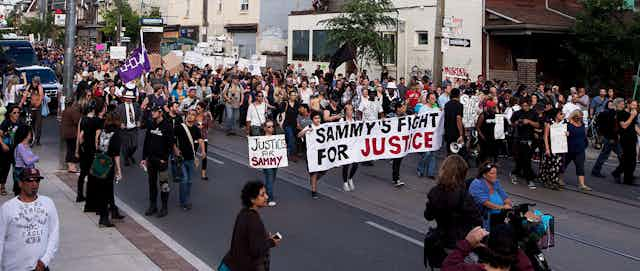Coroner’s inquests into deaths that involved police often focus on the police force’s perspective and experiences. The inquest into the death of Toronto teenager Sammy Yatim, who was fatally shot by Toronto police Const. James Forcillo in July 2013, is no exception.
Because Yatim’s death involved police, the inquest was mandatory under Ontario’s Coroners Act. It draws to a close this week.
Reflecting on the inquest’s focus on officer wellness, it’s appropriate to revisit what coroner’s inquests do, what they don’t do, and to question why these proceedings are often dominated by police perspectives rather than the community’s or the victim’s.
What is a coroner’s inquest?
A coroner’s inquest is a public hearing conducted by a coroner before a jury of community members.
Inquests are designed, as Oxford University police researcher Ian Loader pointed out in a 2020 research paper, to draw out how deaths in police custody are the result of the interaction of factors within society and the police force rather than as the singular act of an individual officer.
Inquests aren’t trials. They’re not designed to linger over the cause of the death. Instead, inquests concentrate on the systems that had an impact on the circumstances of death.

That means that by their very nature, inquests often shut down discussions about the specific acts of murder or neglect that caused the death.
In fact, Sherene Razack, a Canadian critical race scholar at the University of California, Los Angeles, argues in her 2015 book Dying from Improvement: Inquests and Inquiries into Indigenous Deaths in Custody that while coroner’s inquests typically provide the opportunity to discuss police officer wellness and access to resources, it’s often at the expense of the victims of a police officer’s actions.
In her book, Razack contends that inquests are often a means for police forces to communicate that they have a legitimate right to use force. In the process, coroner’s inquests tend to portray their victims as the authors of their own demise, and police officers as the “victims of a hard-to-police population.”
Purpose, scope of the Yatim inquest
In keeping with Razack’s criticisms, the purpose of the Yatim inquest wasn’t to revisit Forcillo’s conduct on the night of the shooting, his record as a police officer or to revisit the facts. Forcillo has already been convicted of attempted murder in relation to the death.
Its purpose was simply to explore “police officer recruitment, monitoring of police officers’ execution of their duties, police officer decision-making and available supports for those decision-making skills.”
This scope included “wellness, how to monitor a police officer’s job performance and what to do when relevant and material worrisome behaviour is noted.”

The presiding coroner, Dr. David Cameron, arrived at this scope after rejecting Forcillo’s request to use the inquest to examine the possibility Yatim died by “suicide by cop.”
Cameron described the inquest as a “unique opportunity to explore what to do when a police officer doesn’t follow their training” in reference to statements Forcillo had made to the parole board about failing to adhere to his training.
Forcillo said he rushed his decision-making and went against his training while under the stress of the situation. He admitted he should have used communication to de-escalate the situation with Yatim, and should have waited for a higher-ranking officer who was able to use alternative methods.
Given these previous concessions, Cameron instructed the court that one of the inquest’s aims is to determine “how we can help officers make better decisions when under stress.”
Forcillo’s testimony takes centre stage
When Forcillo took the stand during the inquest, he made several statements about what might have changed the outcome the night he killed Yatim on a Toronto streetcar.
He suggested that access to a taser “would have changed everything” and that martial arts training would have empowered him to take different action. He testified:
“After I was charged, I learned some jiu jitsu. I tell you if I had that kind of confidence when I was working on the road and I would have had those techniques, I would have been more apt to handle it without resorting to a use-of-force option.”
Forcillo also suggested a lack of support for officer wellness was a contributing factor in Yatim’s death.
It was “not the culture” to discuss mental health, he said.
Wellness strategies
Related to this testimony, the Toronto Police Service presented its revamped officer “wellness strategy” to the inquest jury.
As former deputy chief Mike Federico explained at the hearing, the police force has already changed its intervention policy to lower the threshold for when an officer’s use of a firearm is worthy of an intervention.
The lowered threshold is seemingly meant to identify officers like Forcillo, who had pointed his gun at someone six times in the 15 months leading up to Yatim’s death.
The program, part of Toronto Police Services’ use-of-force reporting system, flags certain officers for a mandatory, non-disciplinary intervention through the police force’s employee wellness unit.
During the hearing, Supt. Lisa Crooker with Toronto police’s hiring and recruiting division was questioned by Ed Upenieks, the lawyer for some of Yatim’s family members, about whether the 2013 version of the early-intervention program was sufficient to stop problem officers.
“So the police were not doing a good job policing the police in July of 2013; do you agree with me?” Upenieks asked.
“There were certainly significant gaps and challenges in that intervention opportunity,” Crooker replied.

Preventing future deaths
After the jury compiles its recommendations at the conclusion of the inquest, it’s up to the police force to decide whether it will make further changes.
But judging by testimony, it appears as though Toronto police are already making efforts on officer wellness.
The motto of the Office of the Chief Coroner of Ontario is: “We speak for the dead to protect the living.”
The question is whether the Yatim inquest has done enough to speak for the dead. Or has it just been a marketing exercise for Toronto police?

